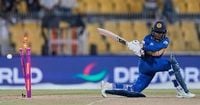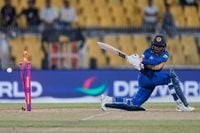The 2025 Women’s Cricket World Cup exploded into action on September 30 as India triumphed over Sri Lanka by 59 runs (DLS method) in a rain-affected opener at the Barsapara Cricket Stadium in Guwahati. With over 22,000 fans braving the weather, the atmosphere was electric—testament to the growing popularity of women’s cricket in the region. The match not only kicked off the month-long tournament but also set the tone for what promises to be a fiercely contested battle for the coveted trophy, set to be decided on November 2 in either Colombo or Navi Mumbai.
India, playing on home soil for the fourth time after hosting in 1978, 1997, and 2013, is chasing its first-ever Women’s World Cup crown. The opening clash was a test of nerves and resilience, with both teams eager to make a statement. Sri Lanka’s captain, Chamari Athapaththu, won the toss and put India in to bat first—a decision that seemed to pay off early as the Indian top order wobbled under pressure and persistent rain interruptions.
Smriti Mandhana, the opener and a key player for India, was dismissed cheaply for eight runs, leaving the home side in a spot of bother. Pratika Rawal and Harleen Deol attempted to steady the ship with a 67-run partnership, but their efforts were stymied by the first of two rain delays. The match was initially reduced to 48 overs per side before a second interruption cut it further to 47 overs each. Rawal contributed 37 runs, while Deol fell just short of a half-century with 48, but both would be dismissed as India’s innings began to unravel.
The middle-order collapse was dramatic. In the 26th over, Sri Lanka’s veteran spinner Inoka Ranaweera spun a web, dismissing Deol, Jemimah Rodrigues (for a golden duck), and captain Harmanpreet Kaur (21) in quick succession. India tumbled from 120-2 to 124-6 in the blink of an eye, with Richa Ghosh also falling cheaply. Ranaweera was the pick of Sri Lanka’s bowlers, finishing with four wickets for 46 runs, and was responsible for putting the visitors in a commanding position.
But cricket is a game of partnerships and comebacks. Deepti Sharma and Amanjot Kaur orchestrated a remarkable turnaround for India. Coming together with the team in deep trouble, the pair put on a vital 103-run stand for the seventh wicket, taking India from the brink of disaster to a competitive total. Sharma, known for her calm under pressure, compiled a run-a-ball 53, while Kaur was even more aggressive, hitting 57 off 56 deliveries. Their partnership was all about grit and smart cricket, as they cut out risky shots and focused on rebuilding the innings.
“My partnership (with Kaur) was the turning point after we had lost back-to-back wickets. We wanted to take the game deep and I am used to such situations. So there was no pressure. First match (of the tournament) sets the tone and we want to keep winning,” Sharma said after the match.
The late-innings flourish came courtesy of Sneh Rana, who smashed 28 not out off just 15 balls, including two towering sixes, to help India post 269 for 8 in their 47 overs. The score was more than respectable given the circumstances and the rain disruptions. The Barsapara pitch, hosting its first ever women’s ODI, seemed to favor batters, but the evening dew was always likely to help the chasing side.
Sri Lanka’s chase began with promise as Hasini Perera and Athapaththu built a steady foundation. Athapaththu, the captain, top-scored with 43 off 47 balls, and together with Harshitha Samarawickrama (29), added a crucial 52 runs for the second wicket. At 103 for 2, Sri Lanka looked well in the hunt.
However, Deepti Sharma was not done yet. She broke the partnership by bowling Athapaththu in the 15th over—a moment widely seen as the match’s turning point. From there, India’s trio of spinners—Sharma, Sneh Rana, and Shree Charani—tightened the screws. Sharma finished with figures of 3 for 54 in her 10 overs, while Rana and Charani claimed two wickets apiece. Indian spinners accounted for seven of the ten wickets to fall, underlining captain Harmanpreet Kaur’s tactical acumen in selecting a spin-heavy attack.
Nilakshi de Silva offered some resistance with 35, but the wickets kept tumbling as Sri Lanka was bowled out for 211 in 45.4 overs. The margin of defeat—59 runs under the DLS method—reflected both India’s resilience and Sri Lanka’s inability to capitalize on their early momentum.
The crowd of 22,843 set a new record for opening day attendance at the Women’s Cricket World Cup, a milestone celebrated by players and organizers alike. The match was also marked by a lively opening ceremony, featuring a performance by Bollywood singer Shreya Ghoshl, adding further glamour to a memorable day.
India’s captain, Harmanpreet Kaur, was quick to praise her team’s fightback. “It was not an easy game. We know in tournaments, every game is important and is going to be high pressure,” Kaur said. “The way they [Amanjot and Sharma] handled the situation was outstanding to watch. I’m really happy all the girls came together to win this game for the country.”
Sharma’s all-round performance, which earned her the player of the match award, also elevated her to second on India’s all-time list of women’s ODI wicket-takers, trailing only the legendary Jhulan Goswami.
Looking ahead, the tournament promises plenty of drama. India’s next clash is a high-voltage encounter against archrival Pakistan on October 5 in Colombo, while Sri Lanka will face defending champions Australia on October 4, also in Colombo. Other key fixtures include Australia versus New Zealand in Indore and England starting their campaign against South Africa in Guwahati.
With eight teams vying for glory across 31 matches in venues spanning Guwahati, Indore, Visakhapatnam, Navi Mumbai, and Colombo, the stakes couldn’t be higher. Pakistan will play all their matches in Colombo, while the final destination—Colombo or Navi Mumbai—awaits the two best teams on November 2.
India’s campaign is off to a flying start, but as every cricket fan knows, the World Cup is a marathon, not a sprint. With the pressure of playing at home and the hunger for a maiden title, Harmanpreet Kaur’s side has shown it can handle adversity. The rest of the field has been put on notice: India means business, and the world is watching.






